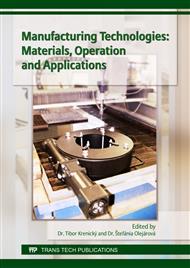[1]
V. Khunová, Polymer nanocomposites (Polymérne nanokompozity), in: Secrets of Chemistry Revealed (Odhalené tajomstvá chémie), SAV VEDA, Bratislava, 2007. (in Slovak).
Google Scholar
[2]
P. Klusoň, M. Drobek, H. Bartková, I. Budil, Welcome to the nanoworld, (Vitajte v nanosvete), Chem. Listy 101 (2007) 262-272. (in Slovak).
Google Scholar
[3]
A. Panda et al., Roller bearings and analytical expression of selected cutting tools durability in machining process of steel 80MoCrV4016, Applied Mechanics and Materials 415 (2013) 610-613.
DOI: 10.4028/www.scientific.net/amm.415.610
Google Scholar
[4]
A. Panda et al., Analytical expression of T-vc dependence in standard ISO 3685 for cutting ceramic, Key Engineering Materials 480-481 (2011) 317-322.
DOI: 10.4028/www.scientific.net/kem.480-481.317
Google Scholar
[5]
A. Panda, J. Jurko, J. Valíček, M. Harničárová, I. Pandová, Study on cone roller bearing surface roughness improvement and the effect of surface roughness on tapered roller bearing service life, International Journal of Advanced Manufacturing Technology 82/5-8 (2016).
DOI: 10.1007/s00170-015-7449-8
Google Scholar
[6]
A. Panda, J. Jurko, M. Džupon, I. Pandová, Optimalization of heat treatment bearings rings with goal to eliminate deformation of material, Chemické listy 105/16 (2011) 459-461.
Google Scholar
[7]
A. Panda, J. Jurko, I. Pandová, Monitoring and Evaluation of Production Processes - An Analysis of the Automotive Industry. Springer Int. Publishing, Switzerland, 2016, 117 p.
Google Scholar
[8]
M. Prislupčák, A. Panda, Comparsion and Analysis of the Flow Rate, Key Engineering Materials 663-696 (2016) 197-204.
Google Scholar
[9]
T. Krenický, Virtual instrumentation as a tool of automated monitoring of operational parameters of technical systems (Virtuálna inštrumentácia ako nástroj automatizovaného monitoringu prevádzkových parametrov technických systémov), in: Proc. of Int. Workshop ARTEP 2010, February 24-26, 2010, Stará Lesná, Slovakia; Košice, TUKE, 2010, p.49.
Google Scholar
[10]
T. Zaborowski, Ekowytwarzanie, Gorzow, Poland, 2007, 100 p.
Google Scholar
[11]
L. Sabová, E. Chmielewská, K. Gáplovská, Preparation and use of combined adsorbents zeolite base at removing oxianionic pollutants from waters (Príprava a využitie kombinovaných adsorbentov na zeolitovej báze pri odstraňovaní oxy-aniónových polutantov z vôd), Chem. Listy 104 (2010).
Google Scholar
[12]
M. Főldesová, P. Hudec, Study of surface properties of Slovak natural zeolite – clinoptilolite by physical nitrogen adsorption. Petroleum & Coal 49/1 (2007) 34-40.
Google Scholar
[13]
P. Hudec, J. Novanský, Š. Morávek, Z. Židek, Influence of various mordenite modification on its physico-chemical and catalytic properties, 5th Italo-Czechoslovak Symposium on Catalysis, San Remo, Italy Sep. 28-Oct. 1, 1987, pp.96-99.
DOI: 10.1135/cccc19920845
Google Scholar
[14]
M. Főldesová, P. Dillinger, P. Lukáč, Š. Svetlík, Effect of calnication and chemical modification of the structure of natural zeolites (Vplyv kalcinácie a chemickej modifikácie na štruktúru prírodných zeolitov), Book of Abstr. XVI Conf. on Thermal Analysis and Calorimetry TERMANAL 2003, PO-6, Stará Lesná, Slovakia, Oct. (2003).
Google Scholar
[15]
Y. Zhang, F. Chen, J. Zhuang et al., Synthesis of Silver Nanopartlicles via Electrochemical Reduction on Compact Zeolite Film Modified Electrodes, Chem. Commun. 23 (2002) 2814-2815.
Google Scholar
[16]
M. Matik, M. Václavíková, S. Hredzák, M. Lovás, Š. Jakabský, Possibility of modifying the zeolite iron oxides and its use in the removal Pb +2 from aqueous solutions (Možnosti modifikácie zeolitu oxidmi železa a jeho využitia pri odstraňovaní Pb2+ z vodných roztokov), Acta Montanistica Slovaca 9/4 (2004).
Google Scholar
[17]
A.B. Bourlinos, R. Zboril R.D. Petridis, Simpler out etowards magnetically modified zeolites, Microporous and Mesoporous Materials 58 (2003) 155-162.
DOI: 10.1016/s1387-1811(02)00613-3
Google Scholar
[18]
S.E. Lehman, C. Sarah S.C. Larsen, Zeolite and mesoporous silica nanomaterials: greener syntheses, environmental applications and biological toxicity, Envir. Sci.: Nano 1 (2014) 200-213.
DOI: 10.1039/c4en00031e
Google Scholar
[19]
M.M. Khin, A.S. Nair, V.J. Babu, R. Mutugan, S. Ramakrihna, A review on nanomaterials for environmental remediation, Energy Environn. Sci. 5 (2007) 8075-8109.
Google Scholar
[20]
E. Chmielewská, Z. Bedrna, Hazardous Substances and Environmental Hazards (Rizikové látky a environmentálne hazardy). 114, Vyd. CICERO, Bratislava, 2007. (in Slovak).
Google Scholar


